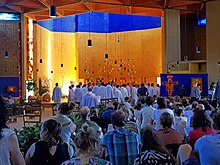My hope and my joy
My hope and my joy is one of Jacques Berthier 1988 for for Taizé -composed hymn , which originally called El Senyor ( Catalan The Lord ) was written in Catalan. In the German-speaking countries, the translated version is best known.
text
In Catalan:
El Senyor és la meva força,
el Senyor el meu cant.
Ell m'ha estat la salvació.
En Ell confio i no tinc por,
en Ell confio i no tinc por.
In German:
My hope and my joy,
my strength, my light:
Christ, my confidence,
in you I trust and am not afraid,
in you I trust and am not afraid.
In English:
In the Lord I'll be ever thankful,
in the Lord I'll rejoice!
Look to God, do not be afraid.
Lift up your voices, the Lord is near,
lift up your voices, the Lord is near.
shape
The song is a four-part short chant characteristic of the Taizé community . In the bass there are two singable note sequences in some places. The song is sung over and over again in a meditative manner. It can be supported by instruments or solo chants.
The song can be sung in 14 languages. It was published - in addition to German and Catalan - in English (In the Lord) , French (Ô ma joie) , Czech (Kazdý den Pán) , Croatian (Jer Gospodin je moja snaga) , Italian (Il Signor) , Hungarian (Jézus életem) , Polish (Pan jest mocą) , Portuguese (O Senhor é a minha forca) , Albanian (Zoti esht'e gjithe forca ime) , Slovenian (Moja múdrost ') , Tagalog (Sa Diyos magpapasalamt) , Russian and Ukrainian translated.
History and expansion
The song was released on the occasion of the European Youth Meeting in Barcelona . 80,000 young people took part in the meeting at the turn of the year 2000/2001. Since its publication it has been consistently included in the Taizé hymnbook, in the current version under song number 17. The rights are held by Ateliers et Presses de Taizé .
The text has a biblical origin and comes from Isa 12,2 EU :
“See, God is my salvation; I trust and do not frighten. For my strength and my song is the Lord God. He became my salvation. "
El Senyor is known far beyond the community of Taizé internationally and also in Germany. In the German-speaking world, it is one of the most frequently sung Taizé songs, with the German translation being mostly used. The song has also found its way into the new praise of God and bears the number 365 in the supra-diocesan section. It is included in various regional editions of the Evangelical Hymnal : Austria No. 641; Württemberg No. 576, Bavaria / Thuringia / Mecklenburg No. 697. It is also a popular song in international Taizé prayers such as the Night of Lights and in church services worldwide.
The song was released on several CDs and gave its name to the CD with Taizé songs that was released in 1999: “Auf Dich Vertrau Ich” (December 5, 1999). The song is also published on “In the Lord (El Senyor)” (November 15, 1988, in English), “Bendecid al Señor!” (June 10, 2000, in Catalan), “Taizé Instrumental 2” (May 24th 2005, instrumental), “Canti della preghiera a Taizé” (December 2, 1998, in Italian), “Liederen uit Taizé” (December 14, 1997, in Dutch), “Sjung lovsång alla länder” (November 20, 1996, on Swedish) and Songs Of Taizé - In God Alone (June 16, 2008, in Catalan).
Web links
Individual evidence
- ^ Ateliers et Presses de Taizé: Chants de Taizé . Ed .: Ateliers et Presses de Taizé. 2017–2018 edition. Ateliers et Presses de Taizé, Taizé.
- ↑ https://www.taize.fr/spip.php?page=chant&song=322&lang=de
- ↑ https://www.amazon.de/s?k=el+senyor+taize
